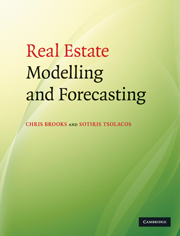Book contents
- Frontmatter
- Contents
- List of figures
- List of tables
- List of boxes
- Preface
- Acknowledgements
- 1 Introduction
- 2 Mathematical building blocks for real estate analysis
- 3 Statistical tools for real estate analysis
- 4 An overview of regression analysis
- 5 Further issues in regression analysis
- 6 Diagnostic testing
- 7 Applications of regression analysis
- 8 Time series models
- 9 Forecast evaluation
- 10 Multi-equation structural models
- 11 Vector autoregressive models
- 12 Cointegration in real estate markets
- 13 Real estate forecasting in practice
- 14 The way forward for real estate modelling and forecasting
- References
- Index
4 - An overview of regression analysis
Published online by Cambridge University Press: 05 June 2012
- Frontmatter
- Contents
- List of figures
- List of tables
- List of boxes
- Preface
- Acknowledgements
- 1 Introduction
- 2 Mathematical building blocks for real estate analysis
- 3 Statistical tools for real estate analysis
- 4 An overview of regression analysis
- 5 Further issues in regression analysis
- 6 Diagnostic testing
- 7 Applications of regression analysis
- 8 Time series models
- 9 Forecast evaluation
- 10 Multi-equation structural models
- 11 Vector autoregressive models
- 12 Cointegration in real estate markets
- 13 Real estate forecasting in practice
- 14 The way forward for real estate modelling and forecasting
- References
- Index
Summary
Learning outcomes
In this chapter, you will learn how to
derive the OLS formulae for estimating parameters and their standard errors;
explain the desirable properties that a good estimator should have;
discuss the factors that affect the sizes of standard errors;
test hypotheses using the test of significance and confidence interval approaches; and
interpret p-values.
Chapter objectives
This chapter introduces the linear regression model and covers fundamental concepts in single-equation regression analysis. Regression analysis is important in itself for modelling and forecasting but it also lays the foundations to study and apply more complex methods, which we cover later in the book. In the real estate literature, regression analysis is used extensively. Problems with data availability have played a part in the continued popularity of linear regression modelling rather than more sophisticated procedures. In practice, regression analysis dominates the empirical modelling of real estate markets. The much-improved access to econometric packages, the ease they offer to run regressions and a greater availability of econometric skill in the real estate field have resulted in more quantitative modelling and a heavier use of single-equation regression models. Of course, data limitations (for example, long-term series may exist for rents but not for vacancy or measures of demand) have confined empirical investigations to standard regression models, which make lesser demands on the data than more general techniques. In addition, the ease of interpretation of the empirical results of single-equation regression models adds to their appeal with real estate analysts.
- Type
- Chapter
- Information
- Real Estate Modelling and Forecasting , pp. 72 - 107Publisher: Cambridge University PressPrint publication year: 2010



